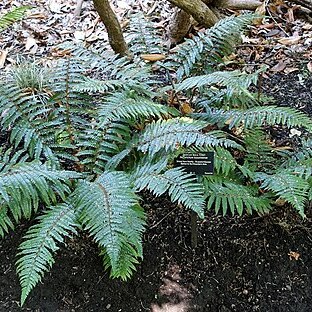Plants terrestrial, epilithic, or rarely low-level epiphytes. Rhizome short, erect to suberect, to 10 mm in diameter, densely set with roots, persistent stipe bases, and paleae; larger paleae broadly attached, castaneous, chartaceous, ovate, narrowly ovate, or lanceolate, cordate, with long twisted uniseriate, gland-tipped hairs on the apical margin and surface, the apex flagelliform, terminating in an oblong thin-walled cell, to 10.5 x 3.3 mm; smaller paleae short-stalked, narrowly triangular to subulate, cordate, the margins proximally with numerous long and twisted uniseriate hairs, distally with widely spaced apically and basally directed marginal outgrowths that become smaller apically, the apex flagelliform, terminating in a small thin-walled cell. Fronds crowded, caespitose, 7-16 per plant, suberect to arching, to 0.93 m long: stipe proximally castaneous, stramineous distally, adaxially sulcate, to 450 mm long x 5 mm in diameter, densely paleated; proximal paleae broadly attached, castaneous, chartaceous, ovate, cordate, proximally entire or with a few short and/or long uniseriate hairs, distally with numerous multicellular hairs as for rhizome paleae; distal paleae short-stalked, narrowly oblong, narrowly triangular or subulate, cordate to hastate, the margins bearing a few long and/or short multicellular hairs proximally, distally with widely and irregularly spaced outgrowths reduced in size and number towards apex, the apex flagelliform, terminating in a small thin-walled cell, to 15 x 1.5 mm: lamina 2-pinnate to 2-pinnate-pinnatifid, with up to 25 free pinna pairs, to 480 mm long, firmly herbaceous to coriaceous, olive-green adaxially, paler abaxially, narrowly ovate to ovate, the proximal pinnae slightly reduced, often somewhat deflexed: rachis stramineous, adaxially sulcate, densely paleated; paleae short-stalked, dark brown to black, glossy, chartaceous to crustaceous, narrowly triangular to subulate, cordate to hastate, the auricles usually bearing long and twisted multicellular and uniseriate hairs some of which terminate in a thin-walled cell, the margins either distally with short, widely and irregularly spaced outgrowths that reduce in size and number towards the apex, or more or less entire in smaller paleae, to 7 mm long: pinnae short-stalked, 1-pinnate to 1-pinnate-pinnatifid, with up to 12 free pinnule pairs, narrowly lanceolate, proximally widely spaced, distally often somewhat overlapping, to 173 mm long: pinna-rachis stramineous, adaxially sulcate, densely set with paleae similar to but less complex than those on the rachis: pinnules widely spaced to overlapping, the proximal acroscopic pinnule the largest, often significantly longer than the next, up to 40 mm long and 12 mm wide, inaequilateral, narrowly trullate to rhomboid, basiscopically cuneate, acroscopically truncate and auricled, often somewhat falcate, lobate-serrate, aristate; proximal pinnules short-stalked, often acroscopically incised to or nearly to the costa; costa adaxially sulcate, glabrous, abaxially sparsely paleated, the paleae castaneous, chartaceous, narrowly triangular-hastate to subulate-hastate, cordate to cordate-imbricate, proximally with long and/or short filiform outgrowths often terminating in a thin-walled cell, the apex always terminating in a small thin-walled cell, to 0.3 mm long. Venation immersed. Sori circular, c. 1.2 mm in diameter, terminal or nearly terminal on abbreviated vein branches, essentially uniseriate: sporangium with 10-(13)-19 indurated annulus cells; stalk eglandular: indusium peltate, circular, entire, repand or crenulate, persistent, brown, pale brown and often dark centred before drying, cupulate when dry, the maximum radius 0.5-(0.73)-0.95 mm. Spores 32 per sporangium, brown, the perispore unevenly folded to form narrow and broad reticulate ridges, the ridges and areas between ridges echinulate, spiculate or verruculate, the exospore 30-(38.84)-50 x 22-(28.2)-36 µm.
Rhizome erect to suberect, c. 7 mm in diameter, set with lanceolate, acuminate, sub-entire, dark brown rhizome-scales c. 10 x 2.5 mm, the surface near the apices with hair-like protrusions. Fronds tufted, arching; stipe pale brown, set with very narrow, almost black scales, broader basally and denticulate, becoming subglabrous with age; lamina firmly herbaceous, ovate-attenuate, truncate, c. 380 x 115 mm, 2-pinnatifid, basal pinnae not or slightly reduced; pinnae curved, narrowly ovate-attenuate, basal acroscopic pinnule largest, pinnatifid; pinnules otherwise usually simple, crowded, lunate, aristae less than 0.5 mm long, subequal, mostly single, upper surface subglabrous, lower surface set with multicellular hairlike scales up to 1 mm long; rhachis set with thick narrow scales, fimbriate basally, dark brown to almost black, c. 5 mm long. Indusium ferrugineous with an atrocastaneous centre and pale undulate margins, subentire, c. 1 mm in diameter.
Rhizome erect to suberect, with ovate, narrowly ovate to lanceolate scales, with outgrowths along margins and surface. Fronds caespitose, suberect to arching, up to 930 mm long. Stipe proximally castaneous, densely set with castaneous, ovate scales, with marginal outgrowths. Lamina 2-or 3-pinnate, narrowly ovate to ovate, with up to 25 pinna pairs. Pinnae narrowly lanceolate, 1-pinnate to pinnatifid. Pinnules firmly herbaceous to coriaceous, the proximal acroscopic pinnule largest, often significantly longer than the next, narrowly trullate to rhomboid, somewhat falcate, lobate-serrate, aristate. Sori round, up 1.2 mm in diam. Indusium round, entire, repand or crenulate.
Terrestrial or epilithic. Rhizome erect to suberect, with dark brown scales. Fronds tufted, suberect to arching, 2-pinnate to 2-pinnatifid, basal pinnae not or only slightly reduced, lamina lanceolate to narrowly ovate, 220-450 x 90-190 mm, subglabrous adaxially, scattered hairlike scales abaxially; pinnules coriaceous, ovate, basal acroscopic pinnule enlarged, bases strongly unequally cuneate, margins serrate-aristate; rachis densely covered with dark brown, hair-like scales; stipe mid-brown, with both hair-like and larger, almost black scales. Sporangia in circular sori with circular, entire indusium, ± 1 mm in diameter.
Rhizome erect to suberect, set with dark brown rhizome scales. Lamina 2-pinnate, ovate-attenuate, ±380 x 115 mm. Rhachis scales suffused with pigment, appearing dark brown to almost black.

